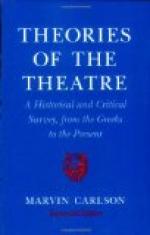It is by no means my intention to suggest that great writing is not desirable in the drama; but the point must be emphasised that it is not a necessary element in the immediate merit of a play as a play. In fact, excellent plays have often been presented without the use of any words at all. Pantomime has, in every age, been recognised as a legitimate department of the drama. Only a few years ago, Mme. Charlotte Wiehe acted in New York a one-act play, entitled La Main, which held the attention enthralled for forty-five minutes during which no word was spoken. The little piece told a thrilling story with entire clearness and coherence, and exhibited three characters fully and distinctly drawn; and it secured this achievement by visual means alone, with no recourse whatever to the spoken word. Here was a work which by no stretch of terminology could have been included in the category of literature; and yet it was a very good play, and as drama was far superior to many a literary masterpiece in dialogue like Browning’s In a Balcony.
Lest this instance seem too exceptional to be taken as representative, let us remember that throughout an entire important period in the history of the stage, it was customary for the actors to improvise the lines that they spoke before the audience. I refer to the period of the so-called commedia dell’arte, which flourished all over Italy throughout the sixteenth century. A synopsis of the play—partly narrative and partly expository—was posted up behind the scenes. This account of what was to happen on the stage was known technically as a scenario. The actors consulted this scenario before they made an entrance, and then in the acting of the scene spoke whatever words occurred to them. Harlequin made love to Columbine and quarreled with Pantaloon in new lines every night; and the drama gained both spontaneity and freshness from the fact that it was created anew at each performance. Undoubtedly, if an actor scored with a clever line, he would remember it for use in a subsequent presentation; and in this way the dialogue of a comedy must have gradually become more or less fixed and, in a sense, written. But this secondary task of formulating the dialogue was left to the performers; and the playwright contented himself with the primary task of planning the plot.
The case of the commedia dell’arte is, of course, extreme; but it emphasises the fact that the problem of the dramatist is less a task of writing than a task of constructing. His primary concern is so to build a story that it will tell itself to the eye of the audience in a series of shifting pictures. Any really good play can, to a great extent, be appreciated even though it be acted in a foreign language. American students in New York may find in the Yiddish dramas of the Bowery an emphatic illustration of how closely a piece may be followed by an auditor who does not understand the words of a single line.




